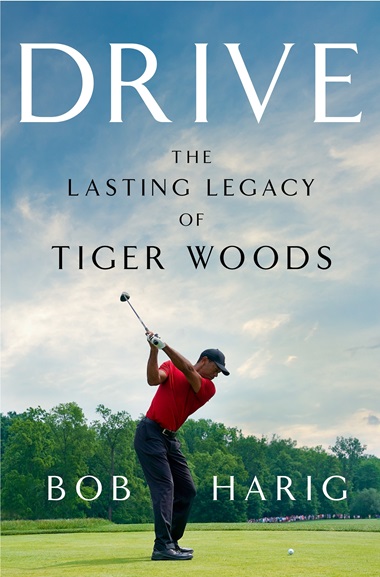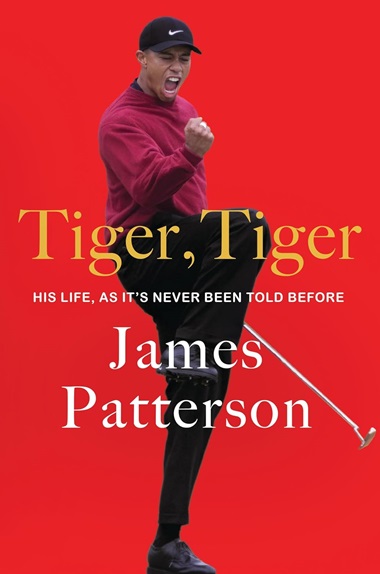By my count, including one roman a clef novel, I’ve read at least ten books specifically about Tiger Woods, and about as many where he’s at least in the mix. And now, Lord preserve me—two new books all about Tiger Woods? What did I do to deserve this, and to live in fear that other writers are, at this very moment, hunched over new manuscripts about Tiger Woods?
 Granted, Bob Harig has every solid credential to write about Tiger, having been on hand for all of his 15 major victories, and the majority of his 82 PGA Tour wins, interviewing him any number of times. The impetus for this book was Tiger’s remarkable 2019 Masters win, but there were two earlier books in the wake of that remarkable comeback, Michael Bamberger’s The Second Life of Tiger Woods and Curt Sampson’s Roaring Back: The Fall and Rise of Tiger Woods (both reviewed here).
Granted, Bob Harig has every solid credential to write about Tiger, having been on hand for all of his 15 major victories, and the majority of his 82 PGA Tour wins, interviewing him any number of times. The impetus for this book was Tiger’s remarkable 2019 Masters win, but there were two earlier books in the wake of that remarkable comeback, Michael Bamberger’s The Second Life of Tiger Woods and Curt Sampson’s Roaring Back: The Fall and Rise of Tiger Woods (both reviewed here).
And is there really more to be said about the Tiger saga in general after the comprehensive Tiger Woods by Jeff Benedict and Armen Keteyian (reviewed here), or Harig’s own Tiger & Phil (reviewed here) about the rivalry between Woods and Mickelson?
To a large degree, there isn’t. And that’s why stretches of Harig’s Drive: The Lasting Legacy of Tiger Woods (St. Martin’s Press, $30) simply becomes boring, repetitive, with a nonlinear chronology and not unlike a long organ recital—thumbing through Tiger’s injuries and operations and comebacks and then more of the same. Add recountings of certain rounds that you can’t get through fast enough. It’s all in service of a thesis that Woods has incredible drive, determination and resilience. But was this ever in doubt?
Still, to release Harig from the woodshed, there are some gems to be found. There’s a fine closer look at one of Tiger’s more remarkable, yet less noted accomplishments, his made cut streak that lasted from 1998 to 2005, 142 consecutive. (Surpassing Bryon Nelson at 113, and Nicklaus with 103. Hale Irwin comes in fourth with 86.)
And Harig is actually at his best when he bypasses the main character and starts quoting the supporting players. In a chapter called “The Admirers” and elsewhere in the book Harig quotes participants who played with or watched Tiger in some of his comeback moments, still attracting massive fan adulation even when hardly playing his best, and their reactions and sense of awe is poignant and compelling.
Steve Lowry, for example, playing with Tiger in the final round of the 2020 COVID-delayed Masters. After taking a ten on the par-3 12th hole, Woods was heading for his worse score ever at the Masters. Then he birdied five of the last six holes. Said Lowry: “We play week in and week out on tour, we go out on Sunday lying in 50th or 60th spot, and you see lads giving up. I don’t give up…. I think I learned even more about it that day from him. He made a 10…. And then he went and tried his nuts off for the last six holes. When the greatest of all time to do it doesn’t give up, the rest of us should follow suit.”
<<<>>>
 The claim for James Patterson’s Tiger, Tiger (Little, Brown and Company, $32.99) is: “His life, as it’s never been told before.” Stylistically, at any rate, that’s surely true. What unfolds for 439 pages, 87 chapters and an epilogue is a relentless barrage of biographical anecdotes culled from an enormous amount of secondary sources.
The claim for James Patterson’s Tiger, Tiger (Little, Brown and Company, $32.99) is: “His life, as it’s never been told before.” Stylistically, at any rate, that’s surely true. What unfolds for 439 pages, 87 chapters and an epilogue is a relentless barrage of biographical anecdotes culled from an enormous amount of secondary sources.
Patterson must have had his researchers sweating like stokers in the archives; one has to go to a website to seek the “Notes” to all his references, which run to 112 pages on their own, so at least some trees were saved in the process. All this by way of saying that Patterson didn’t rely on any primary sources, never spoke to Woods or, as far as can be determined, anyone else in working on the book.
Patterson is clearly an effortless storyteller and a writing machine, best known for hundreds of mysteries, various series, not a few biographies and even three golf novels. He’s had over 100 of his books on the New York Times best-seller lists and has sold hundreds of millions of copies of his various works. And he’s a great supporter of libraries and literacy initiatives.
Yet I confess I’ve not read a one of his books until now, and I can’t say that Tiger, Tiger whetted my appetite. Not that this was a bad reading experience, but it was a bit of an odd one. Patterson sets up his short chapters with a time and a place, and then uses the present tense, creating awkward references to other time frames.
Patterson hits all the highlights of Tiger’s life, from birth right up to the eve of this year’s U.S. Open at Pinehurst (where Tiger missed the cut, as he just did at this year’s Open Championship at Royal Troon). And the amassed anecdotes zoom right along, as though one is enveloped in an hours-long newsreel.
It’s not unpleasant, and it won’t kill you. But it’s hard to imagine any remotely clued-in golf fan learning anything new here. The prose is brisk and uncomplicated, so the ideal audience for the book might be a young reader, or someone new to both golf and Tiger, but curious.
<<<>>>
 Tiger Woods has played—and won—golf tournaments on six continents. Binod “Ben” Thapa has him beat in one regard: as well as playing regulation rounds on six continents, Thapa hit a few balls with a seven iron during a brief shore excursion during a trip to Antarctica.
Tiger Woods has played—and won—golf tournaments on six continents. Binod “Ben” Thapa has him beat in one regard: as well as playing regulation rounds on six continents, Thapa hit a few balls with a seven iron during a brief shore excursion during a trip to Antarctica.
Thapa relates the story in My Golf Journey (Ballast Books, $29.99), an account of his goal to play on all the continents, and 18 holes at a course in every U.S. capital. It takes him about eight years, but he does it.
These golf quest books are becoming more profuse. Author heads off with some knuckle-headed dream in mind and pulls it off, like playing in every state in a year (Tom Coyne in A Course Called America), or playing the Top 100 courses in a year (Jimmie Jones in Playing From the Rough).
If done well, as these both were, the reader is able to ease the indigestion of envy with the vicarious pleasure of joining along. Alas, it is not done well here. Thapa is not an effortless storyteller. While we learn that he drove xx miles and hours from one site to the next, tried to always stay in Marriott hotels, bought what must amount to a storehouse of souvenirs, and most certainly visits all the capitals, the narrative is woefully lacking in any incisive details.
We get the names of the courses he played at, but virtually nothing of their character. (The only time Thapa mentions a course architect he confuses Bobby Jones for Robert Trent Jones Sr.) He mentions, by first names only, all the players he meets, but we almost never learn anything about them or hear a quote from them, or anyone.
 A native of Nepal, Thapa didn’t even play his first round of golf until four years after arriving in the U.S. in 1989. Now he’s a near scratch golfer, we gather, though there’s also little about the nature of his rounds. He seems like an agreeable chap. I’d probably enjoy losing a match to him. But beyond a tip of the cap for his enthusiasm and, well, drive, I can’t really recommend the book.
A native of Nepal, Thapa didn’t even play his first round of golf until four years after arriving in the U.S. in 1989. Now he’s a near scratch golfer, we gather, though there’s also little about the nature of his rounds. He seems like an agreeable chap. I’d probably enjoy losing a match to him. But beyond a tip of the cap for his enthusiasm and, well, drive, I can’t really recommend the book.
This piece originally appeared in the Oct-Nov issue of Golf Oklahoma, in somewhat different form.
